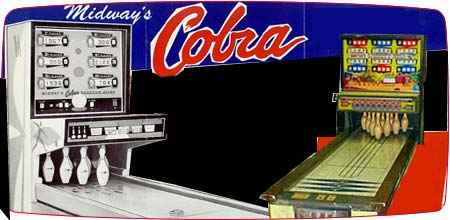Bowling games

Retro Coin Op Synopsis
Bowling games appeared first in the penny arcades of the 1930’s, and back then, they were about the size of pinball machines. The pins were only two inches high, the bowler shot a proportionally tiny ball at them, and all these tiny proceedings took place inside a glass-enclosed alley. Not bad, but in the late 40’s, United Manufacturing—the company that would soon become leader of the bowling coin-op pack—came out with the first shuffle game.
Christened Shuffle Alley, this game was monstrous compared to the bowling games from the decade before, measuring almost ten feet long. It also put a player in more control of the game. When it came to sliding the metal puck toward pins, he decided how hard or soft he wanted to shoot, and whether or not to bank the puck off the side rails. It wasn’t long before shuffle bowling games caught on in a big way, and nearly all the gaming companies of the time eagerly tried their hand at different versions. Arcade owners were so hungry for the trendy machines, in fact, that the company Exhibit sold kits, which converted regular old shuffleboard machines into veritable bowling game extravaganzas.
In the late 50’s, the tiny pins started to get bigger and the alleys grew longer and wider. United’s Bowling Alley used a three-inch ball instead of a flat puck, and bowling realism—or as much as a game designer could muster—was the order of the day. There were also trickier and trickier scoring features to keep players compelled. There was always regulation style, but many games also featured double and triple scores for strikes…if the scoring frame happened to be lit up at the time when the player bowled that strike.
The 50’s and early 60’s were the bowling games’ heyday, and well over a hundred different models were produced. Some of the more novel: Williams’ 1957 pinball-sized Ten Strike, which featured a pint-sized metal mannequin who threw his ball (after the bigger-than-pint-sized coin-op player who controlled him aimed the little guy at the pins); the Big Strike Vertical Bowling Machine, in which a ball was shot onto a board, then dropped down to hit whatever pins were in its path; the early 60’s 5-Way, which let a player choose from regulation, progressive or advanced scoring. Arcade owners and tavern managers organized weekly tournaments.
By the late 60’s, unfortunately, national interest in bowling, and in bowling simulation games as well, began to wane. These were expensive, incredibly heavy machines—not to mention how much room they took up in the arcade. And what’s worse, at least to the coin-op artistes of the time who thumbed their collective noses, the machines, especially the ones from the early 70’s, were renowned for their unimpressive artwork. Traditional shuffle alleys and bowling machine made a bit of a comeback in the mid 80’s, even though the last of their species were manufactured fifteen years before. When the wave of video washed through coin-op games, bowling games with video pins, instead of moving pins, appeared.
Today, some shuffle bowling games still pop up in local arcades—usually with video screens instead of actual pins—but the day of scale-sized rollers, metal mannequins and other inventive arcade bowlers seems to have passed.
Arcade Machine Release History
Mar 1950 - Bowlette - GottliebDec 1957 - Ten Pins - Williams
Dec 1957 - Ten Strike - Williams
Aug 1970 - Mini Bowl - Williams
Arcade Game Sub Categories
sportssimulator
table games
